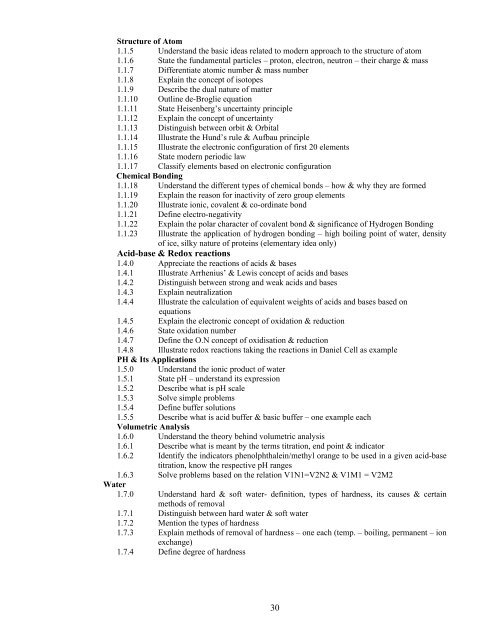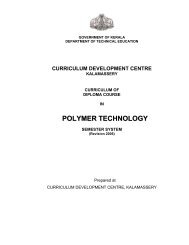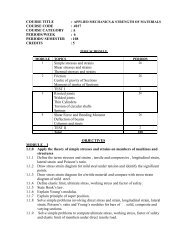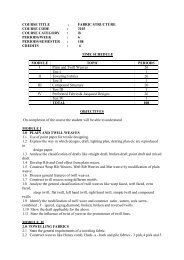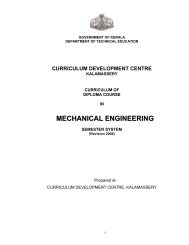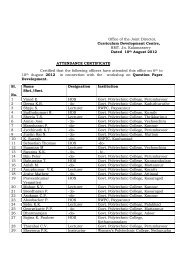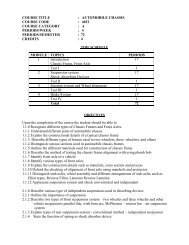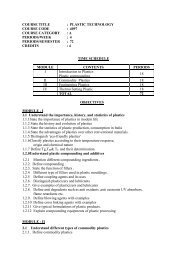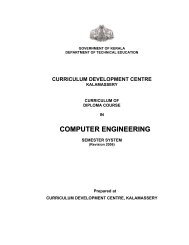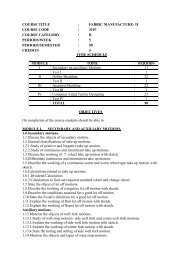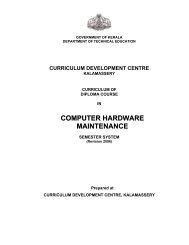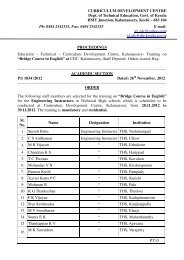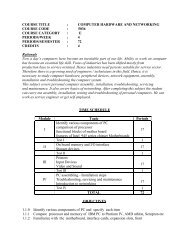13 - Curriculum Development Centre, Kalamassery
13 - Curriculum Development Centre, Kalamassery
13 - Curriculum Development Centre, Kalamassery
- No tags were found...
Create successful ePaper yourself
Turn your PDF publications into a flip-book with our unique Google optimized e-Paper software.
Structure of Atom1.1.5 Understand the basic ideas related to modern approach to the structure of atom1.1.6 State the fundamental particles – proton, electron, neutron – their charge & mass1.1.7 Differentiate atomic number & mass number1.1.8 Explain the concept of isotopes1.1.9 Describe the dual nature of matter1.1.10 Outline de-Broglie equation1.1.11 State Heisenberg’s uncertainty principle1.1.12 Explain the concept of uncertainty1.1.<strong>13</strong> Distinguish between orbit & Orbital1.1.14 Illustrate the Hund’s rule & Aufbau principle1.1.15 Illustrate the electronic configuration of first 20 elements1.1.16 State modern periodic law1.1.17 Classify elements based on electronic configurationChemical Bonding1.1.18 Understand the different types of chemical bonds – how & why they are formed1.1.19 Explain the reason for inactivity of zero group elements1.1.20 Illustrate ionic, covalent & co-ordinate bond1.1.21 Define electro-negativity1.1.22 Explain the polar character of covalent bond & significance of Hydrogen Bonding1.1.23 Illustrate the application of hydrogen bonding – high boiling point of water, densityof ice, silky nature of proteins (elementary idea only)Acid-base & Redox reactions1.4.0 Appreciate the reactions of acids & bases1.4.1 Illustrate Arrhenius’ & Lewis concept of acids and bases1.4.2 Distinguish between strong and weak acids and bases1.4.3 Explain neutralization1.4.4 Illustrate the calculation of equivalent weights of acids and bases based onequations1.4.5 Explain the electronic concept of oxidation & reduction1.4.6 State oxidation number1.4.7 Define the O.N concept of oxidisation & reduction1.4.8 Illustrate redox reactions taking the reactions in Daniel Cell as examplePH & Its Applications1.5.0 Understand the ionic product of water1.5.1 State pH – understand its expression1.5.2 Describe what is pH scale1.5.3 Solve simple problems1.5.4 Define buffer solutions1.5.5 Describe what is acid buffer & basic buffer – one example eachVolumetric Analysis1.6.0 Understand the theory behind volumetric analysis1.6.1 Describe what is meant by the terms titration, end point & indicator1.6.2 Identify the indicators phenolphthalein/methyl orange to be used in a given acid-basetitration, know the respective pH ranges1.6.3 Solve problems based on the relation V1N1=V2N2 & V1M1 = V2M2Water1.7.0 Understand hard & soft water- definition, types of hardness, its causes & certainmethods of removal1.7.1 Distinguish between hard water & soft water1.7.2 Mention the types of hardness1.7.3 Explain methods of removal of hardness – one each (temp. – boiling, permanent – ionexchange)1.7.4 Define degree of hardness30


